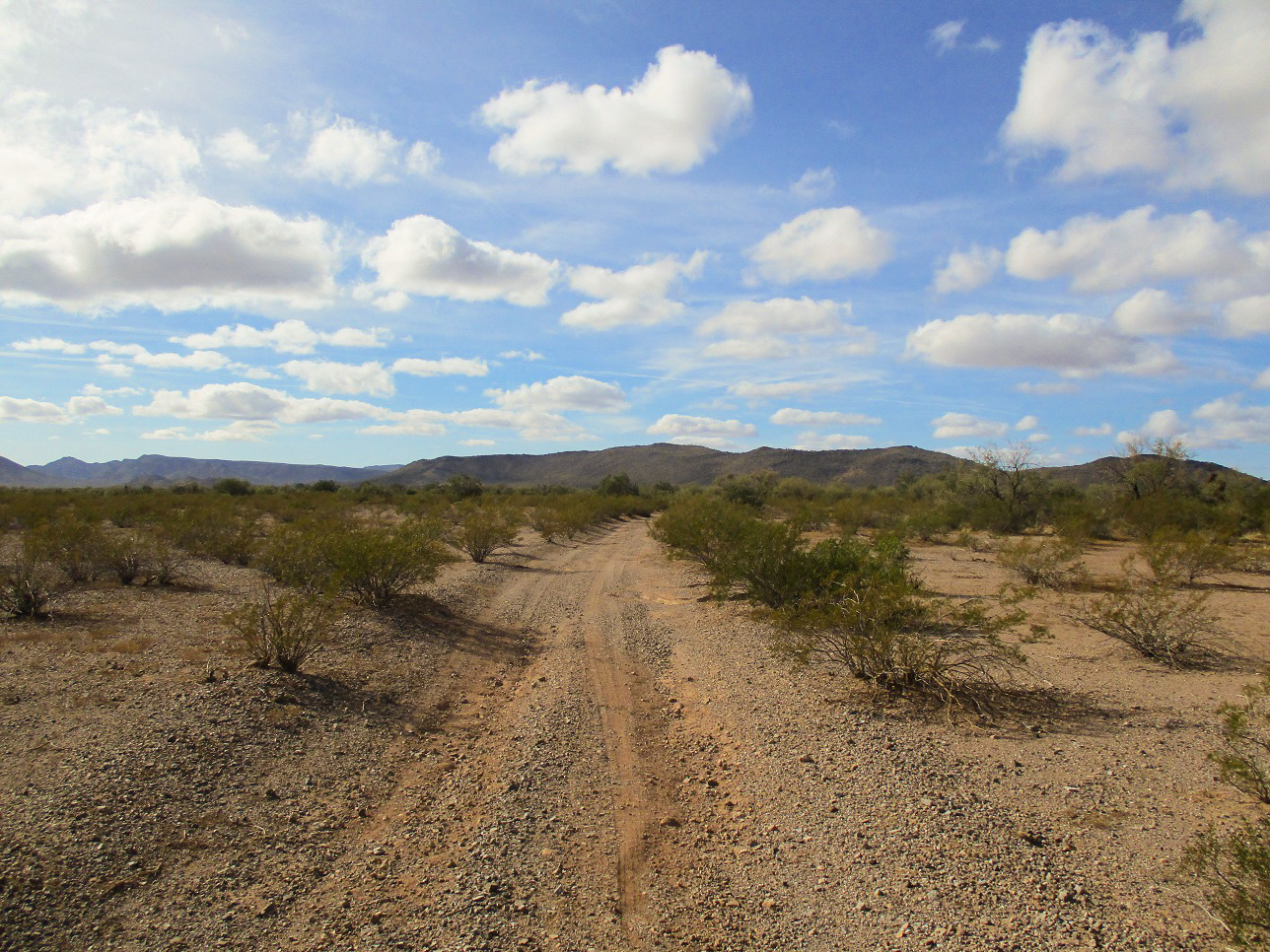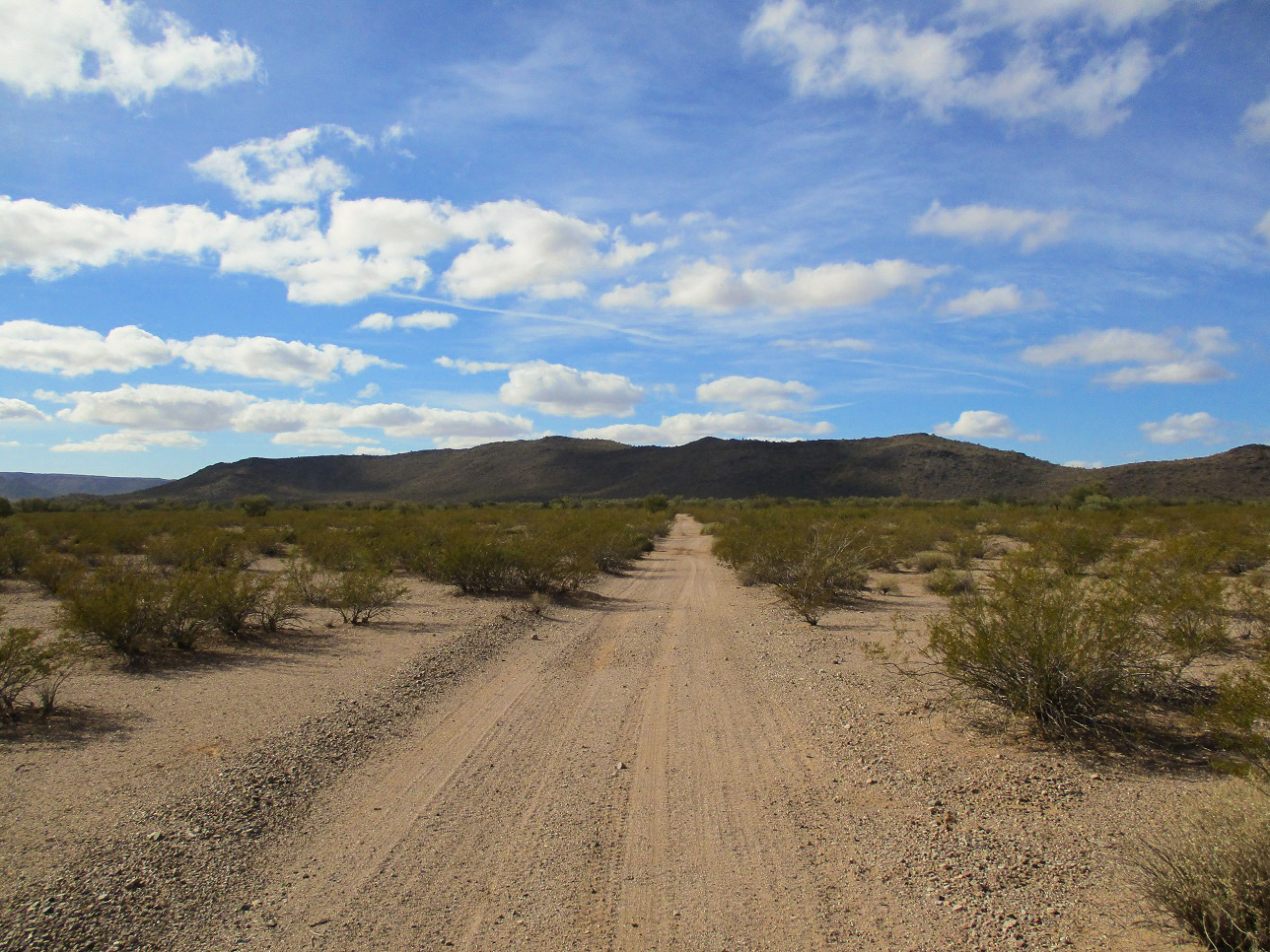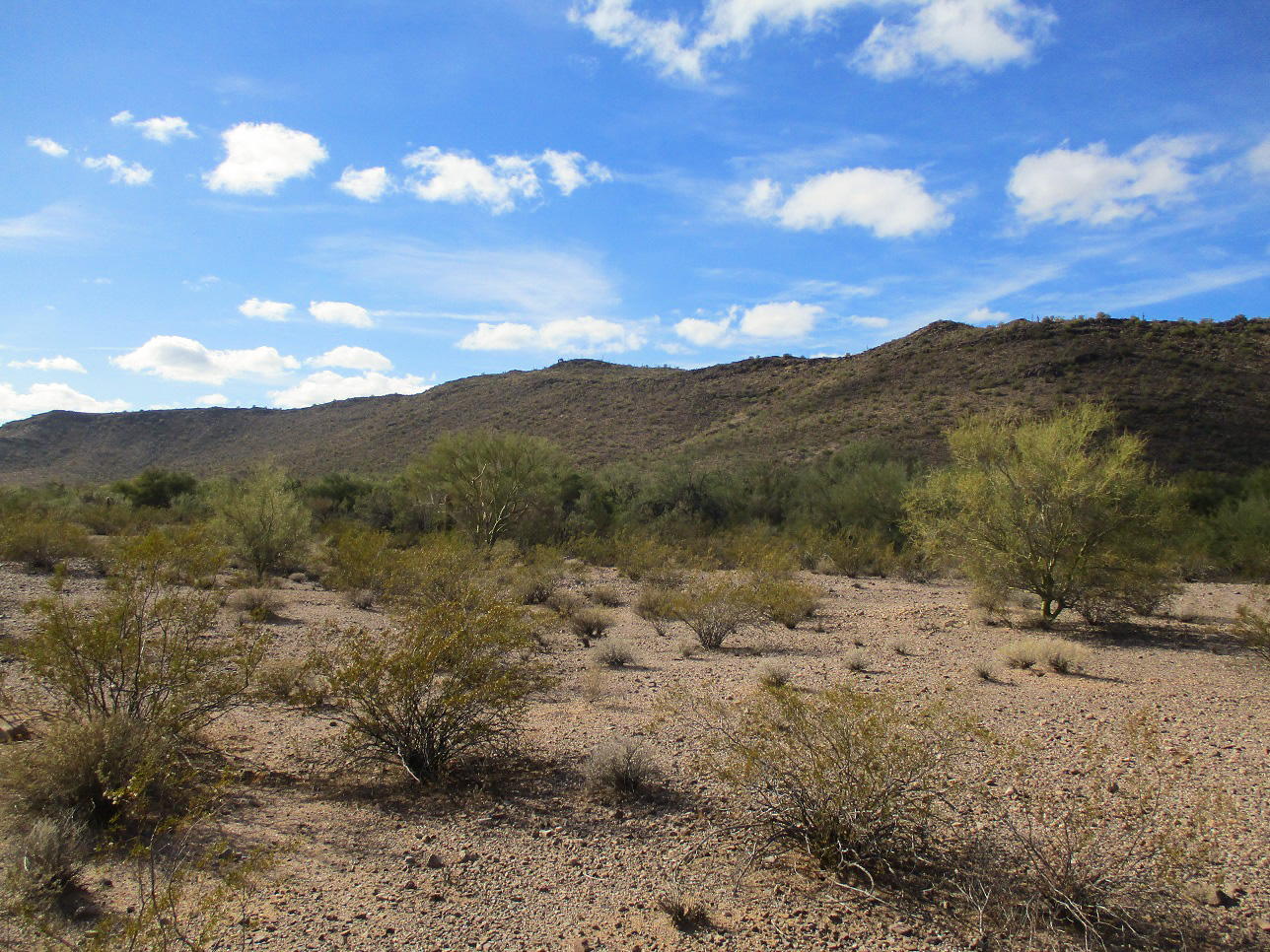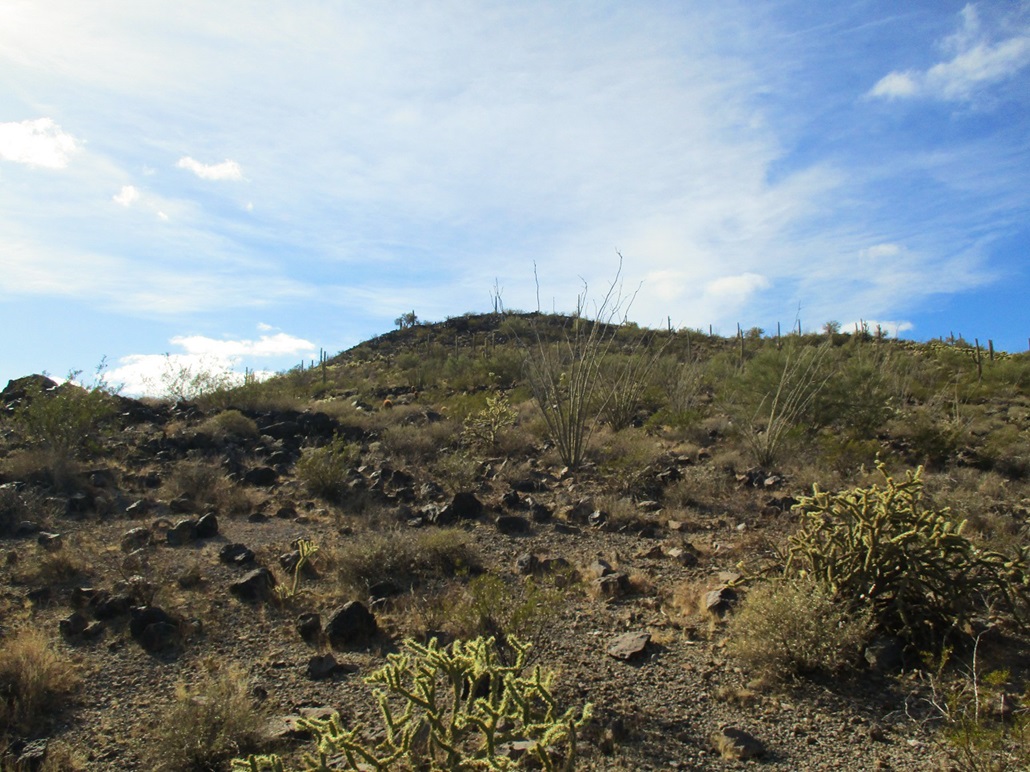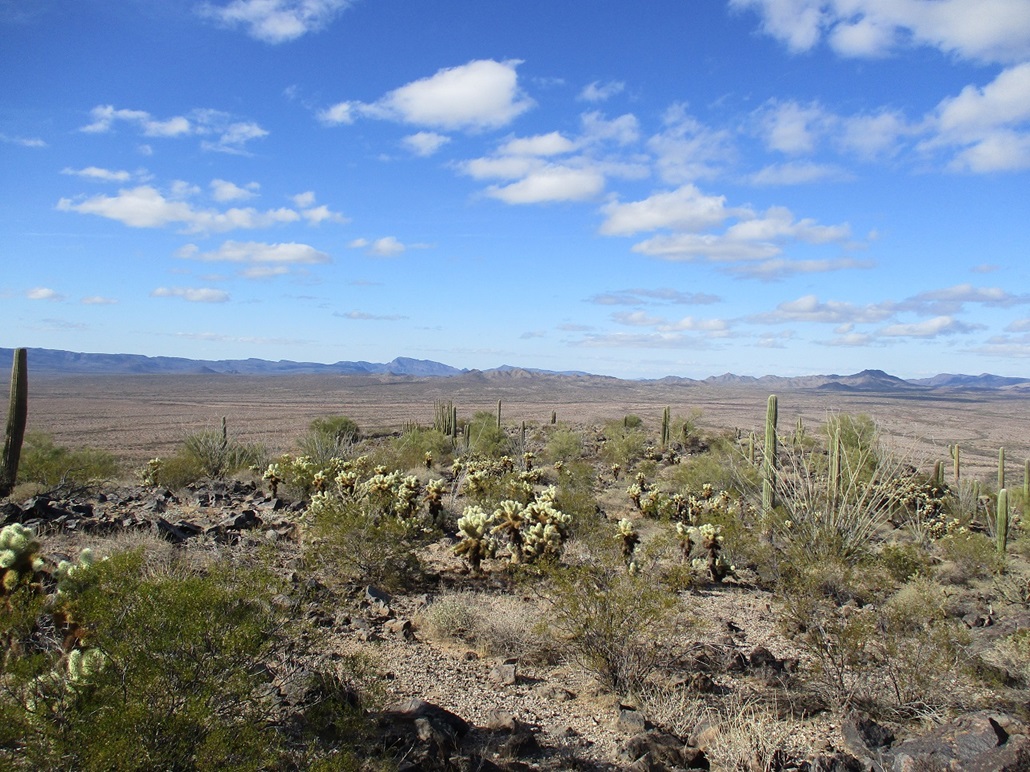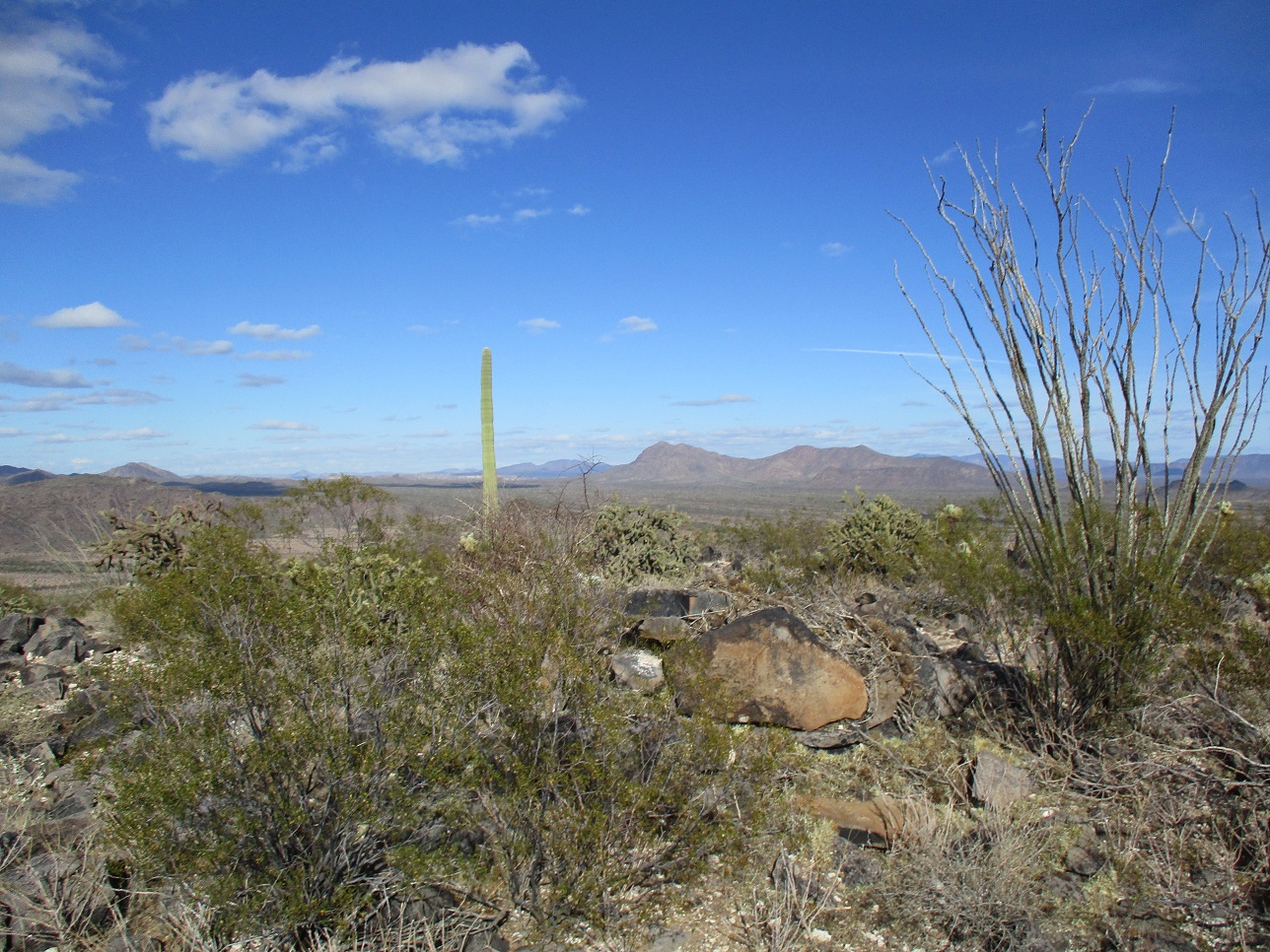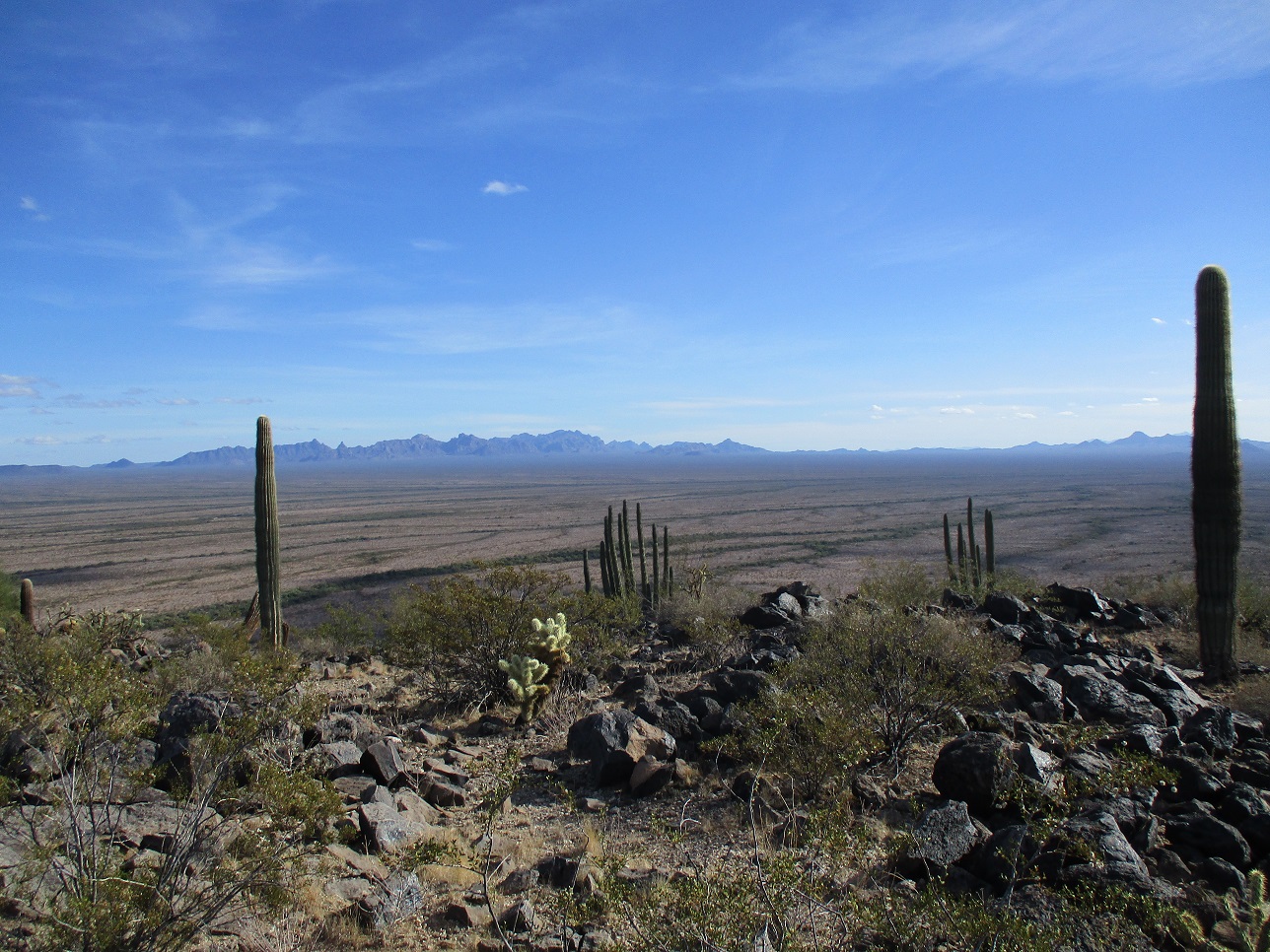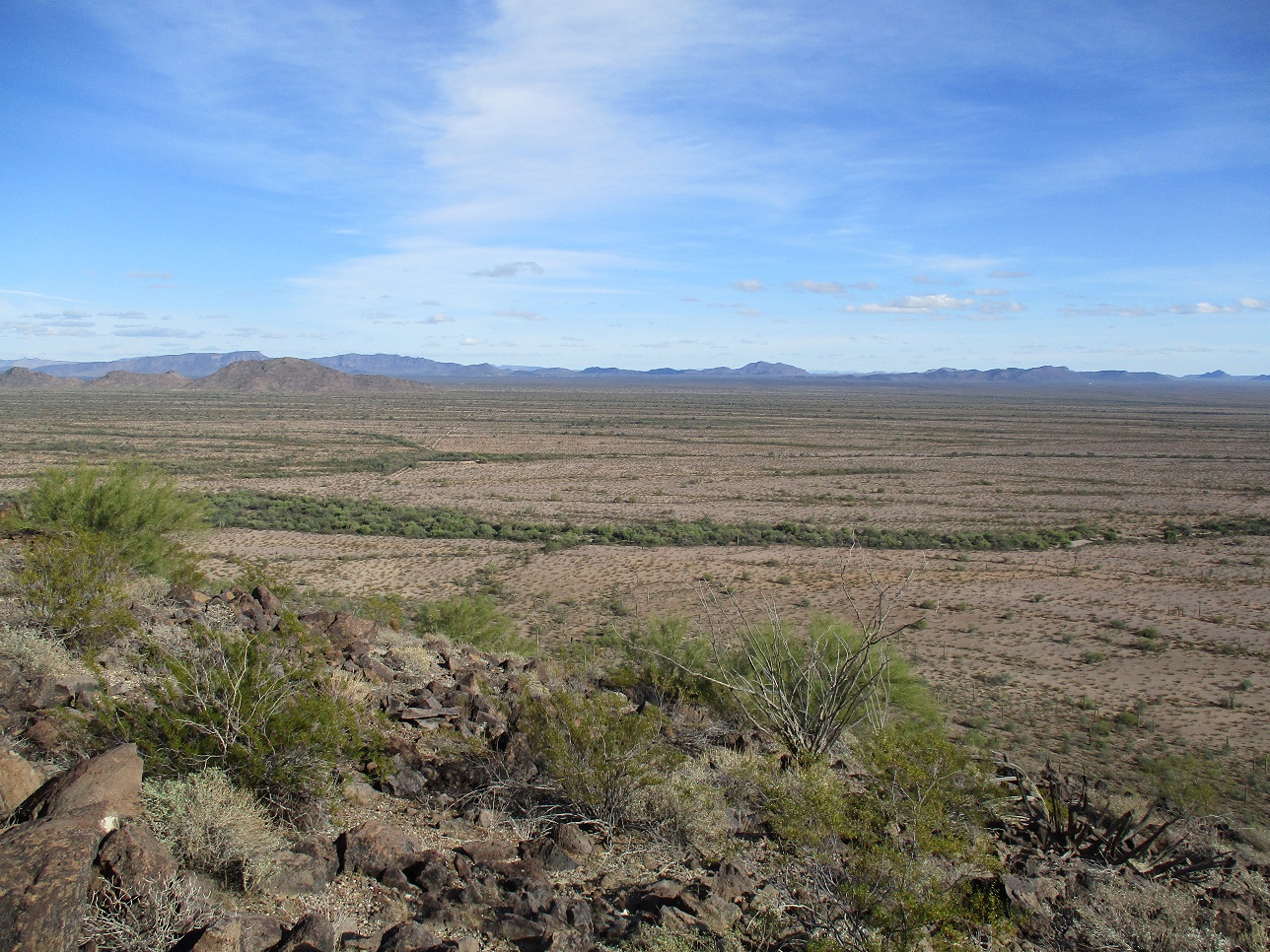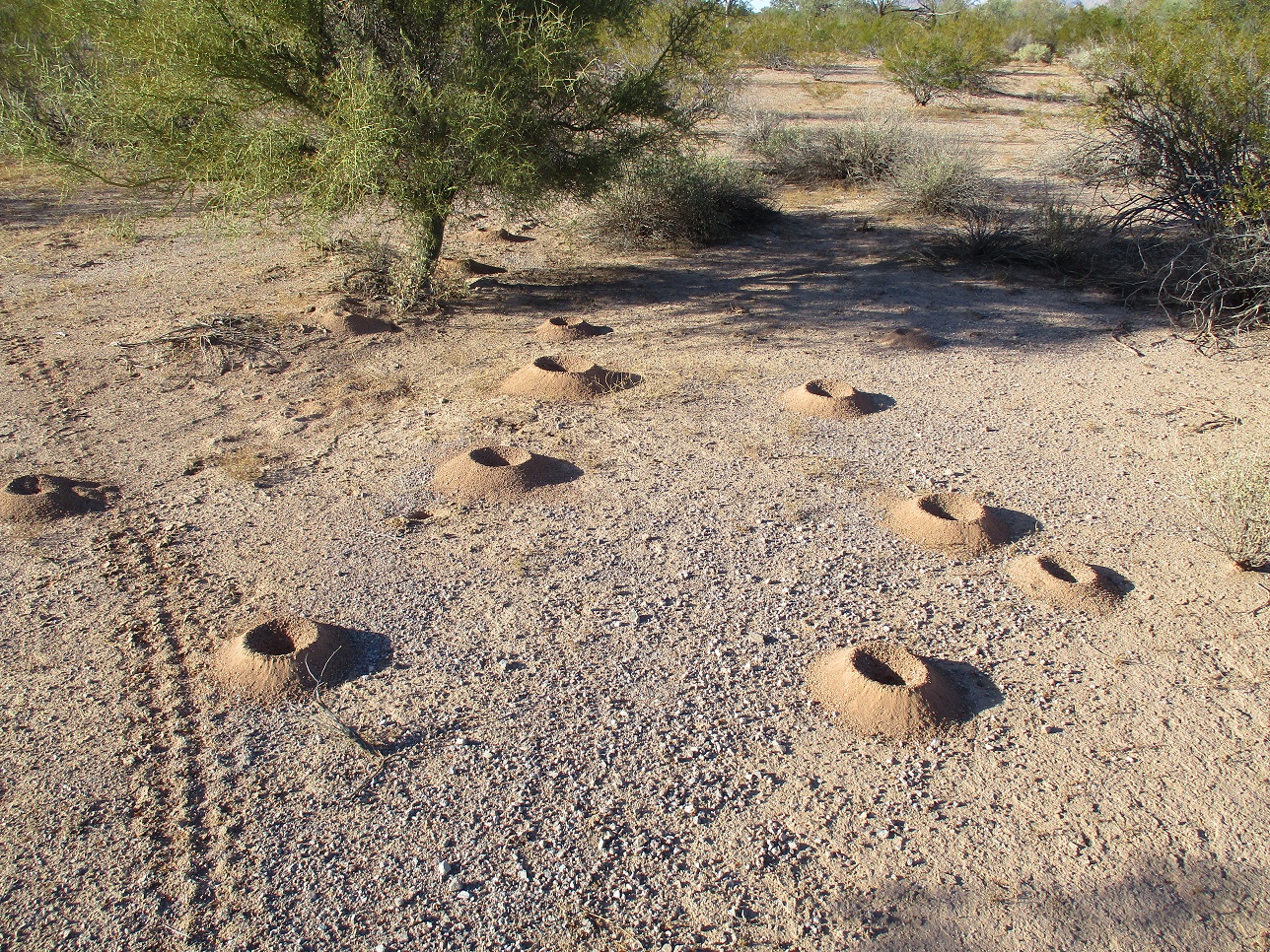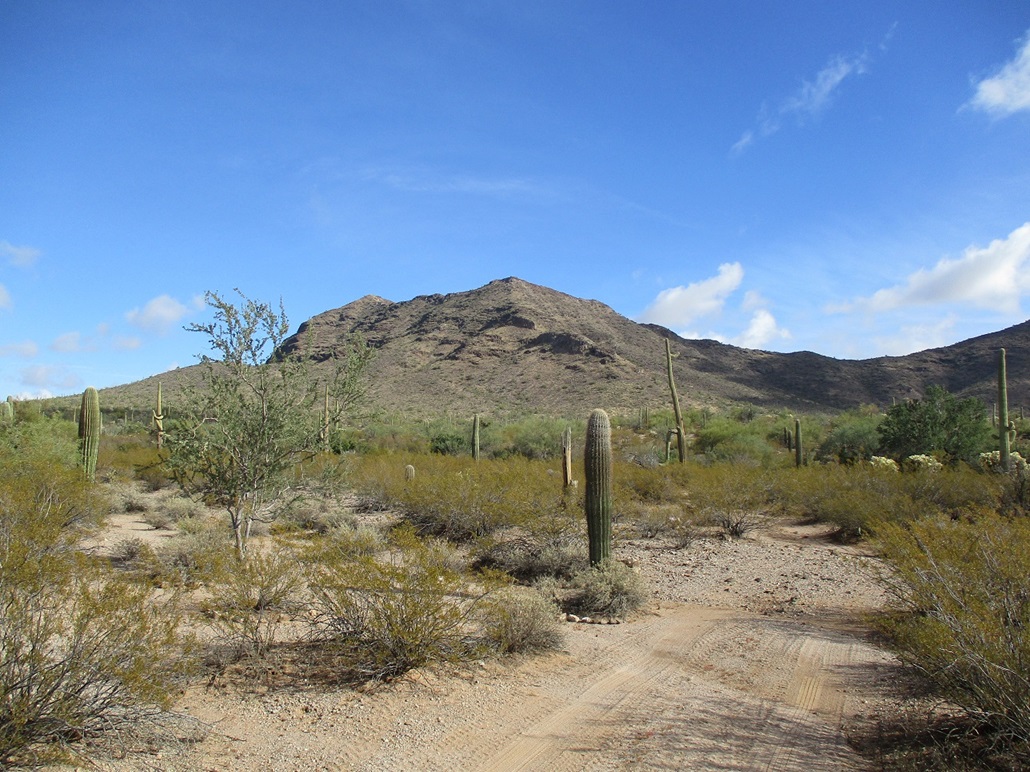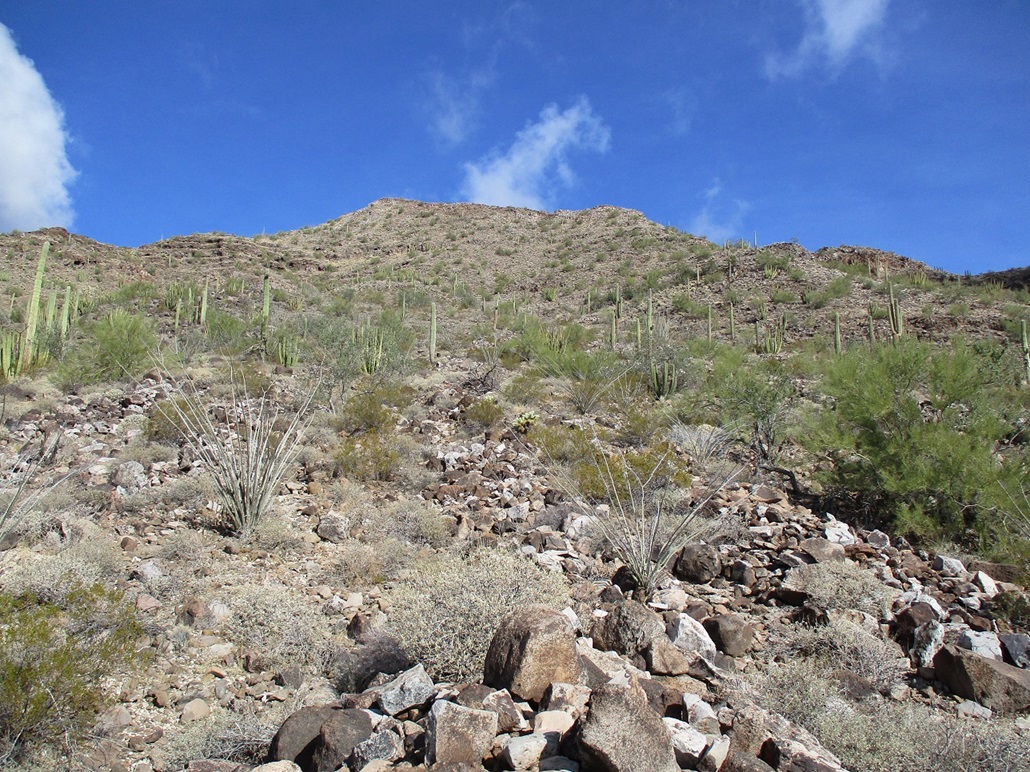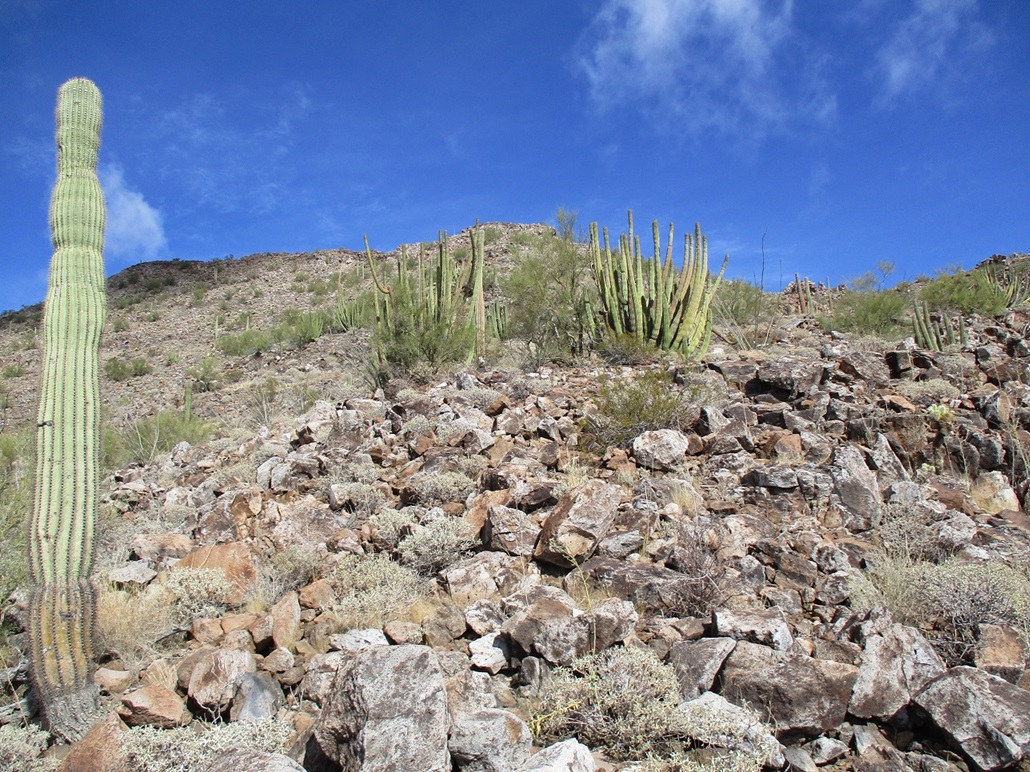
The Mountains of Arizona
• www.surgent.net
|
| John the Baptist Mountain |
• Highpoint: John the Baptist Mountains • Bureau of Land Management • Pima County |
|
Date: December 26, 2021
• Elevation: 2,161 feet
• Prominence: 461 feet
• Distance: 5.8 miles
• Time: 3 hours
• Gain: 515 feet
• Conditions: Sunny and cool
Arizona
•
Main
•
PB
•
LoJ
I planned a two day, one night getaway in Ajo to hike a few peaks. I had maps for a whole bunch of peaks, but primarily I was interested in Peak 2976, the P1K peak west of Ajo, then whatever else I could scare up afterwards. As things turned out, I got a late start and I had a couple unexpected things happen which impacted my plans for the whole day.
I was interested in Peak 2976 because it appeared to have a trail most of the way to its top, and I wanted something easy as I was growing weary of brush and rocks. I was able to track this trail using satellite images and determine where to park to access this trail. This was my primary objective for the day.
I didn't leave Tempe until about 7 a.m., having slept in, but not really by design. I wanted to be on the road by 6, but oh well. I took the usual route into Gila Bend ... or planned to. I got to Maricopa, then onto westbound AZ-238 a few miles. Then a I saw a sign that said the highway was closed up ahead. I was not expecting this. So I turned around, back to Maricopa, then followed the route south through the Ak Chin Community, AZ-84 and Interstate-8 to Gila Bend. This added about twenty miles and a half hour to the journey.
From Gila Bend to Ajo, I had no trouble. In Ajo, I got onto Rasmussen Road, headed west, lost the pavement, followed the dirt portion briefly, then south onto another dirt track. Everything was lining up with what the map showed. The satellite images showed nothing but this road and desert. But then I come to a "gate", a single chain stretched across it, with a No Trespassing sign. There were people back in there and new structures being built. This is exactly where I needed to be to access the trail. Grr.
I backtracked a quarter mile, then parked off the road. My plan now was to hike around this private property piece, and catch the trail on the other side. I followed arroyos and low ridges, then up and down one small knoll, to place me south of the property, where I expected to find the trail. I found nothing. I hiked farther east than I needed to, to be sure I hadn't missed anything. I saw no hint of a trail. I kept at this for about an hour, then gave up. I'd need to do better research.
Back to my car, I left, and drove into Ajo proper, the plan now to hike Camelback Mountain, the main peak in town with an "A" geoglyph on its side and a big cross honoring John Campbell Greenway, who, in the 1910s, helped turn the mining operations in Ajo from small outfits into the giant operation it is today. While other individuals may have founded or established Ajo the town, it was Greenway who made it into the viable mining town it came to be.
Anyway, I drove to a small dirt road and pullout below the A. One other car was there, pieces missing. I really wasn't interested in this peak to begin with, so I bailed almost immediately.
It was about 10:30 a.m. now, and so I chose to tackle Black Mountain, the other big peak in the area and the highest point of the Little Ajo Mountains. I had maps but had not done much research on it, so I'd be hiking this somewhat blind on what to expect. I drove Darby Wells Road south until I was abeam of the mountain, roughly a mile west of its saddle's lowest point.
I looked at the main southwest ridge that my fellow climbing pals had taken in 2019, but I didn't like its cliff bands. I noted another ridge, one to the east, that looked like a big ramp to the range crest. So I hiked to it, and steadily uphill, and yes, it worked fine. I was able to get to the main crest, taking about an hour.
However, the crest itself was not friendly. I had some knife-edge portions to get to the next ridge bump, and I gave a couple a reasonable effort, but decided I really shouldn't be doing this solo, and that maybe this wasn't the best way to go to begin with. So I bailed. I hiked back down and to my car. It was nearing 1 p.m.. I was zero for three so far.
Now I set my sights on John the Baptist Mountain, about three more miles south on Darby Wells Road. John the Baptist Mountain is just a ridge-shaped mound that appeared to have no obstacles or surprises. Even so, I made it harder than it had to be. I knew to look for a road that went west toward the range. There aren't that many to begin with, so when I was roughly northeast of the range, I found a road and it looked good. Immediately, there was an arroyo crossing. I got out to inspect it, nearly stepping on two big white rocks stacked beside the road. This was good to know, as you shall see. I was able to drive in a mile, through about three arroyo crossings overall, but it was clear the road wasn't doing what the map said it should. I realized I was on the wrong road. This stupid road didn't even appear on the map. So I returned to Darby Wells and drove a mile south, finding the "right" road, just past a "Speed Limit" sign. I drove in this road and came to the same arroyo, just a mile south now. Here, it looked too ugly for my car to handle, so I parked it near the arroyo, hiding it as best I could, but not really able to. It was about a hundred feet off Darby Wells Road. This put me a mile farther out than I was hoping, so suddenly, I had a couple extra miles to hike. But I was okay with that. These would be easy road miles. Overall, I was looking at 5 miles round trip, which I knew I could do in a couple hours. It was 1:30 when I started walking. The day was mostly sunny with clouds, but with plenty of blue skies. The state had been hit by a storm over the past two days, so this was a nice change from the cold and gray. The hike in went fine. I walked about a mile and a half, roughly where the locale of "John the Baptist" is shown on the map. Thre was no more road to follow, so I struck off on a beeline toward the slopes under the highest point. I had to cross one more arroyo, and this was nasty. The arroyo was wide and braided, so I had about 300 feet of crud to barge through. On the other side, I was now on the lower slopes, the volcanic rocks now more abundant. The hike to the top went well. I only had to gain about 450 feet to put me on the ridge, then up an easy slope to the top. I was the first to sign in the register in two years, and I spent about fifteen minutes up here, looking around. There were a couple charging stands for walkie-talkies up here, and a pair of shoes, but not much else. The Mexican sentries must not use this peak much. Looking east, the way I had come, I saw that there was an opening in that nasty arroyo, a little to the south. So I would hike down, more east than northeast, and try to cross that arroyo at that opening. Then I would angle northeast and catch the road I had hiked in on. Sounded like cake. I got off the mountain quickly, then headed generally east. I realized I didn't have the elevated view to see where this opening was, so I gave up on that idea and just pushed through the brush and tangles again, now back onto desert flats. I then angled on a northeast bearing, using the hills opposite me as bearing devices. I knew to aim for the south tip of a low hill beside the road. I knew that as a failsafe, I would encounter Darby Wells Road no matter what. But what I intended to do was intersect that lesser road I had walked in on. Then I'd just hoof that road out to my car. I didn't give anything a second thought. The walk was tedious but easy. I just walked and walked, and walked some more, and walked ... and walked. I had to cross a few more arroyos but these were easy. I'd look back to gauge my position relative to the John the Baptist Mountains. I was starting to get this odd feeling that I was too far northeast. That would mean somehow I walked right over the road, which seemed impossible to me because it was a very well defined road. I kept trending northeast under the assumption I'd hit my road. This is a good example of putting blinders on. I was convinced that I could not have missed the road, but clearly I did. It may have been when I was in an arroyo, or in an area where it wasn't that well defined. But I never stopped to consider that possibility. I could tell relative to the mountains east and west of me I was too far north. So yeah, you're probably wondering why I don't have my GPS on. I didn't have it with me and usually don't bring it with me. I still like to navigate by sight and reckoning, and in the desert, this is usually quite adequate. I was still not worried, I knew I'd hit Darby Wells Road. I finally got to where I could see some metal fence posts and then a faded BLM road marker sign. I found a road, yay! The I saw those two white rocks. I was on the darn road a mile north of where I should have been. Man, I was really surprised, and a little annoyed too. How could I have missed it that bad? Well, I did. I got onto Darby Wells Road, walked it a mile south to the proper road, and there was my trusty car, just waiting for me. I had added about an extra mile and a half to my hike, but surprisingly, it was just 4:30 when I settled in to the car. I had been gone just 3 hours. But I was beat. Combined with my hikes earlier today, I had put on a lot of miles and elevation gain. I was happy to finally tag a peak, but admitted that I didn't cover myself in glory today. Among other things, I plan to have my GPS with me for now on. At least enter my car's location, as a minimum. I don't need to follow breadcrumbs, I just need to know where it is and its bearing, and I have a compass for the rest. It was getting chilly now, the sun starting to set. I drove into Ajo, got a few things at a Circle K, went to their supermarket just as they closed, so I ended up getting a sub sandwich for dinner from the Chevron Food Store. I stayed the night at the Copper Sands Motel, and vegged, which felt great. Tomorrow, I would hike a couple of peaks north at Black Gap before heading home. The range is not named for John the Baptist from the Bible. It's actually named for a man named John Butala, born in 1880 and who was a Spanish-American war veteran. He settled into the desert, living in a simple shack, at the "John the Baptist" locale shown on the map. He was apparently handy and would sometimes work in town to fix things, but he mostly lived a solitary life in the desert, wearing just a loin cloth, allowing his hair to grow long and matted, and befriending the wildlife in the area. He was known as the "Desert Prophet". He died in 1961, and the range came to be known as the John the Baptist Mountains soon thereafter. His is an interesting story, and people have theorized he may have been suffering from PTSD or had a mental break as a result of his wartime experience, but no one can know for sure at this point, and he did manage to eke out a life for himself for the better part of half a century. There are worse ways to handle mental conditions, if he actually had one (my guess is he probably did). I can now claim both highpoints in the United States named John the Baptist. In 2004, I tagged the St. John the Baptist Parish highpoint in Louisiana, surprisingly, almost 17 years to the day (off by one). I believe I am the first person to ever to do this. I feel tingly. So, to summarize, the day had been one thing after another, and even on the peak I succeeded on, I made it harder than necessary. All I can do is learn from such errors and do better next time. |
|
